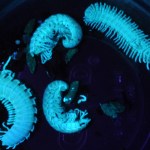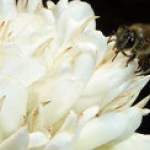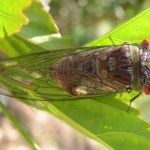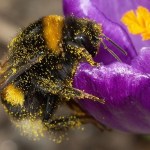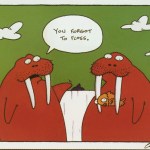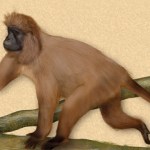Life Science
Fluorescing millipedes. Image credit: Robert Kimsey
Alcatraz is even more exciting that I had previously thought! Early last year the National Park Service had baited rats on the island with a non-toxic fluorescent food dye so they could track the animals as they left behind fluorescent droppings. Volunteers from the UC Davis entomology club along with workers then searched the island using black lights to find evidence of the rodents. Finding fluorescent millipedes instead was quite a surprise for the UC Davis entomology group! Dr. Robert Kimsey and…
I am so excited! The Experimental Biology meeting is only 23 days away and is already reportedly on track to be one of the largest meetings yet. I can't wait to catch up on what's new in comparative physiology at the meeting (along with many other topics). I will be sure to share the highlights.
Entomologist Dr. Coby Schal at North Carolina State University studies the chemicals involved in insect communication in an effort to more effectively manage pests. His big interest is in chemical communication using pheromones and how they impact mating and other behaviors. His research has aided the control of cockroaches, bed bugs, mosquitoes and other nuisance bugs in major cities.
A very nice biography of his work was recently published in The Scientist. Some major discoveries that Dr. Schal made as a graduate student included observing that male cockroaches sit higher up in foliage in…
Apparently I have too much free time on my hands today. I came across this cute video describing how the digestive system of a horse differs from that of humans. The video was created by Jill Johnston, a student at University of New Hampshire, Manchester.
In honor of the 125th anniversary of The American Physiological Society, a history of its founding was just published in Advances in Physiology Education. It reads like a Who's Who list of some of the most important contributors to our understanding of modern physiology. Where would physiology research be in this country without this important society and the hard work of its founding fathers?
Founders of The American Physiological Society from Ryan, 2013
To read more about these pioneering men, and the history of physiology in the US, click here.
Source:
Ryan KL. APS at 125: a look back…
I just came across two blogs dedicated to all things jellyfish:
JellyBiologist
Jellyfish Aquarist
Who knew there were so many people interested in jellyfish to warrant such wonderful blogs! I admit spending a lot of my free time this weekend on these blogs reading about these fascinating creatures. I found the JellyBiologist blog on Beroe jellyfish, known for eating other jellyfish, fascinating. Here is a video of these jellies from the blog:
For prior Dr. Dolittle posts on jellyfish, see:
-Amazing symbiotic relationship between algae and jellyfish
-Relaxing with jellyfish
-Engineering…
Honeybee visiting a coffee flower, photo from Geraldine Wright
Apparently humans and honeybees share something in common when it comes to caffeine. Dr. Geraldine Wright (Newcastle University, England) discovered that bees are more likely to return to flowers that produce nectar containing caffeine. Their data suggest caffeine improves memory in bees. Caffeine is present in higher concentrations in the leaves and other tissues of the plant where it provides the added benefit of warding off predators.
According to a quote from The New York Times by Dr. Robert a Raguso at…
Image from Flickr EOL; Taken by Arthur Chapman
The animation below from Nature shows a bacteria rupturing after landing on nanopillars present on the surface of a clanger cicada (Psaltoda claripennis) wing. Dr. Ivanova (Swinburne University, Australia) and colleagues showed that nanopillars rupture the bacteria by straining the cell wall.
Some scientists see this as an opportunity to create anti-bacterial surfaces in public places simply by coating the surface of objects with nanopillars.
Sources:
Nature
Pogodin S, Hasan J, Baulin VA, Webb K, Khanh Truong V, Nguyen THP, Boshovikj V,…
Image from: Wikipedia, P7r7
New research from Dr. Daniel Robert and colleagues at the University of Bristol shows that bees are not only attracted to the bright colors and smells of flowers, they can also sense their electrical field.
It has been known that bees develop positive charges as they bump into small charged molecules during flight, resulting in a loss of electrons from their surface. In contrast, flowers accumulate negative charges on their petals as they lose positive charges to the surrounding air. The interaction between a positively charged bee and a negatively charged…
I read an interesting article today on how eating insects may save the world. The rationale: eating insects are not only nutritious (high in protein and fat), but would also help to save the Earth's resources as the human population continues to expand.
According to Aaron T. Dossey, a biochemist, entomologist, and founder and owner of All Things Bugs, humans consume ~40% of potential terrestrial productivity and livestock currently takes up ~30% of the Earth's land (pasture and growing feed). With the growing population of humans, food consumption will necessarily increase. He sees insects…
Image of rat teeth from Scienceline (credit: The International Rice Research Institute, flickr.com)
What does tooth decay have to do with rats? For Neandertals, tooth decay was a rare occurance. Research suggests that tooth decay became more prominent with the development of agriculture. Dr. Ordaz, Stanford School of Medicine, and colleagues analyzed common strains of bacteria (Streptococcus mutans) responsible for causing cavities. They found that the bacteria began expanding exponentially around 10,000 years ago, similar to the dawn of agriculture. The…
Image of beagle from www.dogbreedinfo.com/beagle.htm
Diabetes is characterized by high blood sugar. The cause of high blood sugar differs for people with type 1 versus type 2 diabetes. For type 1 diabetics, the pancreas produces little or no insulin, the hormone responsible for lowering blood sugar. For type 2 diabetics, tissues in the body are not responsive to insulin, termed insulin resistance, resulting in persistently elevated blood sugar. Muscle tissue is the main site of glucose disposal in the body and therefore, the main site of insulin's action.
Researchers from Universitat…
Trace amounts of oxazepam in rivers has large effects on wild perch. Image credit: Brent Christensen
Dr. Tomas Brodin (Umea University, Sweden) and colleagues have discovered that trace amounts of the drug oxazepam that ends up in rivers and streams (from toilets) greatly effects local fish. The drug is used to treat anxiety in humans and also calms fish. However, for wild perch, which normally hunt in schools, the antisocial effects of the drug in fish makes them more vulnerable to predation.
Psychiatric medications are not the only…
Image from: Collectors Weekly
Ever wonder how to tell if "scientific" information that you find on the internet is believable or just plain bogus? I came across a website called Sense About Science that explains how research is published and how to determine if it is credible. They also give advice and answer questions about claimed scientific evidence.
Here is a synopsis of the scientific peer review process: After a study is conducted and data has been gathered and analyzed, scientists summarize their findings in a paper that they submit for publication to a journal…
Image of Dr. Brian Hare from Dognition website.
I just found out there is a website, Dognition, dedicated to helping you discover just how smart your furry friend is. The site claims that dogs are actually smarter than we think and that even the apparently dumbest dog is intelligent in one way or another. (There is hope for my dog after all!) The scientist behind the website is Dr. Brian Hare, Associate Professor of Evolutionary Anthropology at Duke University.
Image of camel from ukmedix news.
Researchers from King Abdulaziz University (Jeddah) have tested the effectiveness of micro and nanoshells for delivering a substance from camel urine, PMF701, thought to be a cure for cancer. These findings will be presented at the 2nd Biotechnology World Congress (Feb 18-21).
PMF701, not yet approved by the Saudi Food and Drug Authority, is currently in clinical trials. In a quote published by SciDev.net, the head of the university's tissue culture unit and the principal investigator of the project Faten Abdel-Rahman Khorshid stated, "We made a…
An artist’s reconstruction of the kipunji (Lophocebus kipunji), drawn from a research video shot in the Ndundulu Forest in southern Tanzania and officially described in 2003. Image fromNATIONAL SCIENCE FOUNDATION
I just read an interesting article published in The Scientist today about cryptozoology, a field of research specializing in the study of animals about which only anecdotal or partial evidence exists. In other words, no actual specimens have been studied...think Big Foot or the Loch Ness Monster. There is now a new peer-reviewed scientific journal, The Journal of Cryptozoology,…
You may recall a prior blog entry about a new experimental treatment for bone cancer in dogs. Researchers are increasingly studying canine cancer and discovering that it is caused by some of the same genetic mutations that cause cancer in humans.
Shown in the image above is Jasper, a 7-year old dog that has lymphoma, cancer of the immune system (white blood cells) that is similar to non-Hodgkin lymphoma that afflicts people. Researchers are hoping that studying the DNA of dogs with cancer may lead to treatments for not only dogs, but also people. The…
Image of yellow lab from Wikimedia Commons
New genetic analyses supports the argument that the domestication of man's best friend coincided with the advent of argiculture and human settlements. Researchers Erik Axelsson (Uppsala University, Sweden) and colleagues present evidence suggesting that wolves became domesticated as they increasingly scavenged in the human settlements. The researchers sequenced DNA from 12 wolves and 60 dogs to find areas that evolved under selection pressure. What they found were differences in genes relaed to the development of the…
